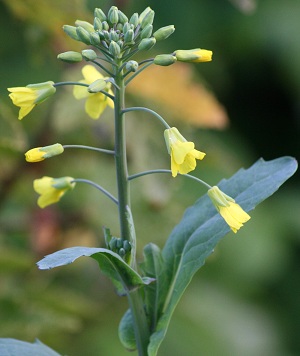 Asparagus Kale shoot - in September!
Asparagus Kale shoot - in September!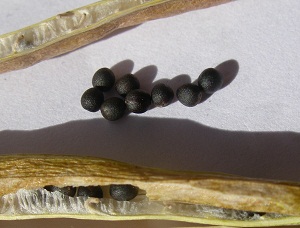 Asparagus Kale pods and seed
Asparagus Kale pods and seedAsparagus Kale is the most wonderful of vegetables! The leaves have a more delicate flavour than cabbage or other kales and can be eaten through the winter even when picked frozen solid. In spring the plants start to grow taller, producing lots of new leaves, and in late spring (April to May here, depending on the weather) copious quantities of tender shoots appear, similar to sprouting broccoli but with a much more subtle flavour. Keep picking and the plant keeps producing for several months, even beyond midsummer here (again, dependent on the weather). You can tell if a shoot is still tender by attempting to snap it off - if it won’t it has become too chewy (or try higher up the stem). Eventually hot weather leads the shoots to flower quicker than you can eat/freeze them. By this stage the plants will be around 5 feet tall, covered with typical yellow brassica flowers - and bees. Next green seed pods are produced which eventually turn dry and brown and contain small brown seeds. Left to their own devices these pods split scattering the seeds.
The garden here in Cumbria is at an altitude of almost 900 feet so very windy and the soil is clayey, but not too heavy, over limestone. All brassicas seem to do well and the kale has never yet suffered worse than cabbage white caterpillars and the odd aphid.
This kale does very well here and as I have deliberately allowed it to flower has seeded itself around the garden. Seedlings spring up in odd places at unusual times of year and can be cropped. As a result we have kale plants at different stages of growth so leaves to eat all year round and a longer season of shoots.
Kale will cross easily with other brassicas in flower. The recommended isolation distance is about half a mile, so to be absolutely certain of genetic purity plants for seed should be grown within an insect-proof barrier, eg mesh or polytunnel. This garden is fairly isolated, our nearest neighbours being nearly half a mile away, and land nearby is pasture rather than arable. So I decided to risk contamination and see what happened - so far I have not noticed any changes in my kale plants, although perhaps there are subtle differences I’ve not spotted. However, this means that I cannot guarantee this seed is completely pure. Please let me know if you think your kale plants are not as they should be.
Cultivation of Asparagus Kale is much as for sprouting broccoli and it is usually grown as a biennial. I have previously started seeds off in a seed tray in late spring then transplanted them when reasonably robust into their final position, eg a few inches apart, although now I have a lot of seed I might try sowing seeds direct and thinning. I’ve found that so far virtually all seeds have germinated. Seedlings suffer a little from slugs but plenty survive. The plants need to be strong and well established (but not necessarily huge) before the onset of winter in order to be in a position to make good flower shoots the following spring. You might need to thin the plants out as they can get big in their second year. The soil doesn’t have to be massively fertile and the kale needs little attention apart from firming it after hard frosts and strong winds.
Caz Walker
Chris and Caz who live between Shap and Bampton usually have spare seed available free.
We obtained our seed in the late 1990s from the Heritage Seed Library of the HDRA, now Garden Organic. Regulations limit the varieties of seed that can be sold in the EU to those that are registered as Distinct, Uniform and Stable. The HSL preserves other varieties so as to maintain the genetic diversity of those interesting varieties that do not meet the needs of the commercial growers. The HSL and their seed guardians propagate these saved varieties and share them with others.
If you can, let the asparagus kale seeds ripen and share with others when you have enough. The birds like the seed in the autumn. So when it is nearly ripe, in September say, cut the plants and put them upside down in a dry paper sack for a week or two. Shake the bag, remove the plant and collect the seed from the bottom. As with other seed, store overwinter in a cool, dry, dark place.
From the Heritage Seed Library Catalogue 2004:
Asparagus kale: an old variety, listed in Vilmorin's 'The Vegetable Garden' in 1885. Reputed to be one of the tastiest of kales and is treated like broccoli. The young leaves can be eaten over winter but it is better left to spring when the young flower shoots can be broken off, blanched and eaten like asparagus.
Relatively dwarf, hardy and prolific, Seed Guardian Mary Eastwood adds, "The small shoots were really delicious, tender and tasty" and the second sowing produce "delicious mild-flavoured leaves ideal for a stir fry." Naomi Griffiths noticed that ringed by 'Asparagus' kale leaves, tender crops like runner beans, squash, lettuce, courgette etc avoid decimation by slugs and snails, so go on to survive and grow to maturity.
- Try this Kale soup recipe
Asparagus kale seeds are available for free, subject to availability. If you would like to have some posted to you, please send a small Stamped Addressed Envelope (SAE) with a Large Letter stamp to Lake View, Bampton, Penrith CA10 2QU. Or make a donation to PACT to cover postage and packing costs - leave special instructions asking for free seeds. Suggested minimum donation: £2.50. Please use the Paypal donate option on the right; please put the address for the seeds in a message with the donation.
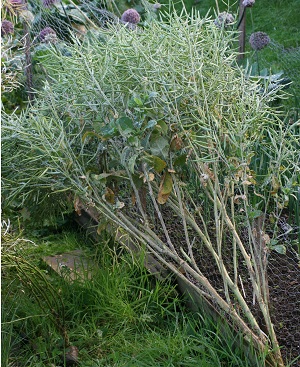
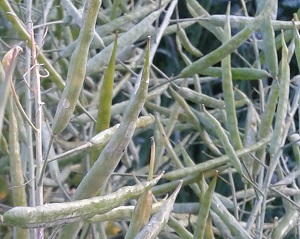
Asparagus Kale going to seed
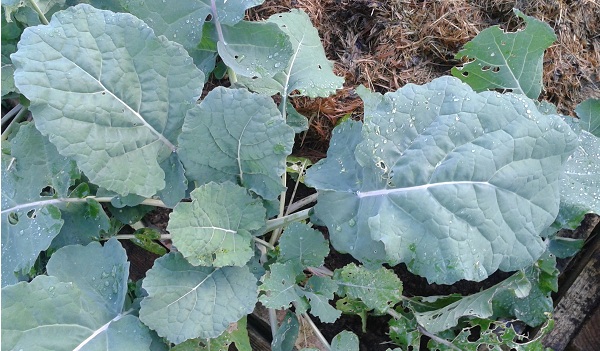
Asparagus Kale
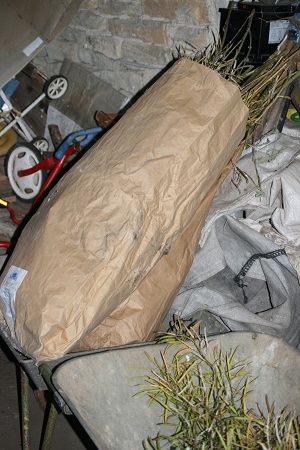
Asparagus Kale seeds being harvested in a dry paper bag
| Attachment | Size |
|---|---|
| 17.5 KB |


